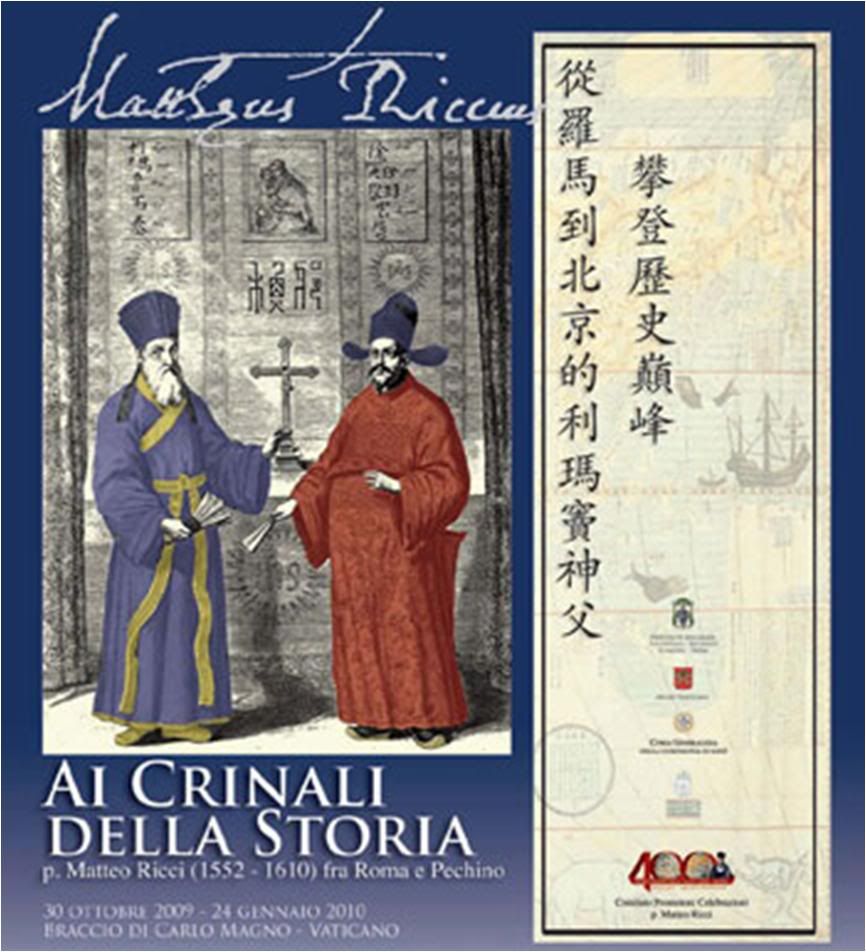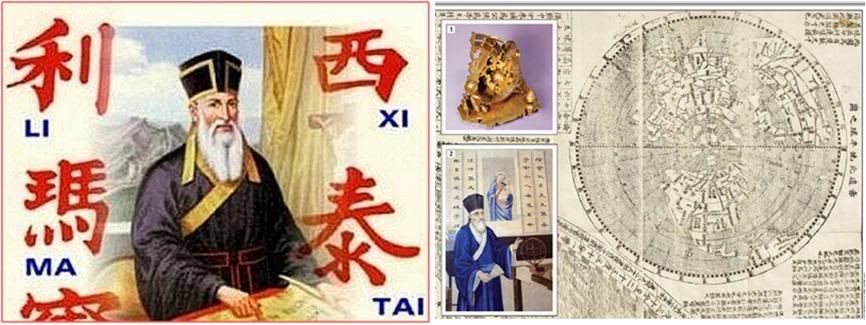
 Portraits of Ricci, his tomb in Beijing, and a monument to him at Beijing's Immaculate Conception churchyard.
Father Ricci's lesson:
Portraits of Ricci, his tomb in Beijing, and a monument to him at Beijing's Immaculate Conception churchyard.
Father Ricci's lesson:
How to "inculturate" Christianity in China
An exhibition at the Vatican offers the great 17th-century Jesuit missionary as a model.
Even for Beijing authorities as well, tne man they affectionately call "Li Madou" is a national treasure.


ROME, November 13, 2009 – From this month until January 24, those who visit Rome will see in Saint Peter's Square a huge display showing two figures in Chinese dress, with writing in the Mandarin language.
The figure on the left is the Jesuit Matteo Ricci (1552-1610), the one on the right is a high-ranking Chinese official whom he baptized, Xu Guangqi.
At the fourth centenary of his death, an exhibition has been dedicated to Matteo Ricci in the Braccio di Carlo Magno wing of Saint Peter's Square.
 At the Vatican on Nov. 4, Pope Benedict XVI is presented with a copy of the exhibit catalog.
At the Vatican on Nov. 4, Pope Benedict XVI is presented with a copy of the exhibit catalog.
An exhibition in his honor will also open in Beijing in February, before moving on to Shanghai, Nanjing, Macau, and finally Seoul.
Matteo Ricci is one of the very few foreigners who have taken their place among the fathers of Chinese history. In the Millennium Center in Beijing, an immense edifice celebrating the glories of the nation, the gigantic bas relief in multicolored marble dedicated to the history of China, from the first emperor to the protagonists of the twentieth century, bears only two images of foreigners, both of them Italian.
One is Marco Polo at the court of Kublai Khan, the other is Matteo Ricci himself, dressed as a Mandarin Confucian and looking out at the horizon.
At the end of last October, at the People's University of Beijing, Matteo Ricci was also the center of attention for the scholars taking part in a major international Sinology conference. He is even considered the creator of this discipline.
The conference was organized by Yang Huilin, vice-rector of the People's University and one of the most proficient scholars of Christianity in China. Speakers at the conference included Hans Küng, as an author of studies on the Chinese religions, and Gianni Criveller, an Italian member of the Pontifical Institute for Foreign Missions, who gave a talk about how the Jesuits who came to China on the heels of Matteo Ricci used images to represent the Christian faith in its totality.
The Sinology conference concluded in an emblematic way: with a dinner in the Forbidden City, the site of the imperial throne but also the epicenter of the work of many missionaries in the 16th and 17th centuries. Matteo Ricci – Li Madou for the Chinese – is buried not far from there.
***
The exhibition in Saint Peter's Square unfolds in two sections: the first, with a blue background, illustrates Rome and Europe during the 16th and 17th centuries; the second, with a red background, houses works and documents from that era in China. The visitor makes the same journey that Matteo Ricci did over his lifetime.
On the first half of the journey, the eye is drawn above all to a masterpiece by Rubens, a large canvas in flaming colors depicting the glory of Saint Ignatius of Loyola and his followers.
On the second half, the visitor is struck by an altar of Confucius in lacquer and gold, of imposing dimensions, across from a pensive and compassionate Buddha, the perfect representation of the refined philosophical Chinese religious sensibility.
When Matteo Ricci entered the Society of Jesus it was 1571, the year of the battle of Lepanto, when the Christian fleet stopped the Turkish assault on Europe. But the spirit that moved the young Jesuit was not that of a Christianity in a state of siege. On the contrary.
At the inauguration of the exhibition, Vatican Museums director Antonio Paolucci described the missionary audacity of Matteo Ricci:
Together with the Christian good news, Li Madou brought to China Euclidean geometry, astronomy, mechanics, cartography. He brought the 'De Amicitia' of Cicero that he had transcribed in an exquisite Mandarin booklet dedicated to a senior dignitary who was a bit Confucian, a bit animist, a bit Christianized.
He therefore brought the culture of the West, signified in the exhibition by astrolabes, planetary models, maps of the city and of the empire.
He also brought Christianity, naturally. But he did so by using the entryway of science and technology, the shared heritage of both West and East, and in any case by treading very lightly, with an extraordinary capacity for assimilation, with absolute and exquisite respect for the culture and traditions of the country he had decided to make his own.
He became Chinese among the Chinese, he even wore the distinctive garb of the imperial official, he was as ceremonious and indirect, as hyperbolic and bureaucratic, as poetic and pragmatic as custom and etiquette required.
If he had not behaved in this way, he would not have had the honors that modern China grants to him and that permit us to place him, truly, at the summit of history.
It was a history that was too soon interrupted but that today, at a time of integration founded on dialogue and therefore on respect and understanding, seems more relevant than ever."

Also at the inauguration, Bishop Claudio Giuliodori of Macerata, Matteo Ricci's birthplace, highlighted the "global" nature of his activity:
He designed mappa mundi that introduced the Chinese to the rest of the world that was largely unknown to them, marking out on these large maps the places most important for Christianity.
He translated into Chinese books of philosophy, mathematics, and astronomy, and introduced the West to the texts of Confucius. He established a very intense dialogue with the most illustrious men of letters and culture in China, turning these conversations into books that were in part intended to prepare the soil for the sowing of the Gospel.
This led to the 'Real meaning of the Lord of Heaven', published in Beijing in 1603, and also explains the extraordinary success of the book 'Ten Paradoxes', published in Beijing in 1607, in which Matteo Ricci addresses the great questions of life in a philosophical tone.
He thus succeeded in laying solid foundations for the penetration of the Gospel and for mutual understanding between East and West, between China and Europe, between Beijing and Rome, opening a new phase for the history of humanity not unlike the one opened a century before, on the opposite side of the planet, with the endeavor of Cristoforo Colombo.
Additional information from

“Ricci’s method of dialogue and inculturation is still relevant, and in many ways has not been surpassed,” Mons. Giuliodori said.
He also revealed that the cause for Father Ricci’s beatification is making headway. He plans to lead a pilgrimage from Macerata to Beijing to pray at the priest’s tomb in 2010 and expressed the hope that the day would soon come when the Church will declare him a saint in recognition of “his missionary genius, his moral and spiritual stature, his openness and cultural far-sightedness.”
Jesuit Father Federico Lombardi, director of the Holy See Press Office, expressed that same hope but added that he would also like to see the Jesuits’ first and perhaps greatest Chinese convert, Xu Guangqi, who worked closely with Father Ricci, canonized alongside him.
The exhibition is organized by the Committee for the Celebration of the Fourth Centenary of Father Matteo Ricci [organized by the Diocese of Macerata] in collaboration with the Vatican Museums, the General Curia of the Company of Jesus, and the Pontifical Gregorian University in Rome.
[Modificato da TERESA BENEDETTA 10/02/2010 00:25]